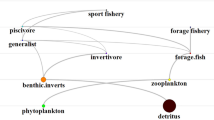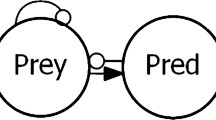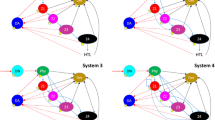Abstract
Understanding and predicting patterns arising from the dynamics of marine food webs is central to trophic and community ecology and numerical models of food webs constitute a primary tool to simulate these dynamics. Food web simulation models are often highly complex while at the same time often too constrained to reproduce the level of variability observed in real systems. The recently developed non-deterministic network dynamics (NDND) modelling framework has been suggested as a simulation alternative, which can generate multiple patterns of food web variability despite great structural simplicity. Two important aspects of the NDND modelling framework remain unexplored: first the derivation of model input parameters from empirical or theoretical studies and second the evaluation of the model simulations against observations. We provide a methodology for the derivation of model parameters based on empirical observations, the metabolic theory of ecology and life-history theory and apply it to the specific case of the Barents Sea food web. We then evaluate the ability of the NDND simulations to reproduce a wide range of patterns of food web dynamics against observations collected in the Barents Sea during 28 years. Patterns emerging from the simulations include trends and cycles in biomass, trophic levels and transfer efficiency, density-dependent growth, top-down vs bottom-up oscillations, ecosystem level stability and synchrony and trophic functional responses. The ability of the NDND to generate so many patterns observed empirically in the Barents Sea is remarkable given that it is based only on random trophic interactions operating within few constraints set by ecological rules. Our results show that investigations of food web dynamics in marine ecosystems, including the definition of reference states and responses to climate and exploitation pressures, may be achieved with models that are structurally simple and based on few well-established assumptions.







Similar content being viewed by others
References
Aubin JP. 1991. Viability theory. Berlin: Springer.
Aubin JP, Bayen AM, Saint-Pierre P. 2011. Viability theory: new directions. Berlin: Springer.
Allesina S, Pascual M. 2008. Network structure, predator–prey modules, and stability in large food webs. Theor Ecol 1:55–64.
Beckage B, Gross LJ, Kauffman S. 2011. The limits to prediction in ecological systems. Ecosphere. doi:10.1890/ES11-00211.1.
Bell RJ, Fogarty MJ, Collie JS. 2014. Stability in marine fish communities. Mar Ecol Prog Ser 504:221–39.
Blanchard JL, Pinnegar JK, Mackinson S. 2002. Exploring marine mammal-fishery interactions using ‘Ecopath with Ecosim’: modelling the Barents Sea Ecosystem. Sci Ser Tech Rep CEFAS Lowestoft 117:1–52.
Blenckner T, Niiranen S. 2013. Biodiversity-marine food-web structure, stability, and regime shifts. In: Roger P, Ed. Climate vulnerability. Oxford: Oxford Academic Press. p 203–12.
Blumer A, Ehrenfeucht A, Haussler D, Warmuth MK. 1987. Occam’s razor. Inform Process Lett 24:377–80.
Brown JH, Gillooly JF, Allen AP, Savage VM, West GB. 2004. Toward a metabolic theory of ecology. Ecology 85:1771–89.
Burnham KP, Anderson DR. 2002. Model selection and multimodel inference: a practical information-theoretic approach. New York: Springer.
Christensen V, Walters CJ. 2004. Ecopath with Ecosim: methods, capabilities and limitations. Ecol Mod 172:109–39.
Clark JS, Carpenter SR, Barber M, Collins S, Dobson A, Foley JA, Lodge DM, Pascual M, Pielke R, Pizer W, Pringle C, Reid WV, Rose KA, Sala O, Schlesinger WH, Wall DH, Wear D. 2001. Ecological forecasts: an emerging imperative. Science 293:657–60.
Cury P, Shannon L, Shin YJ. 2003. The functioning of marine ecosystems: a fisheries perspective. In: Sinclair M, Valdimarson G, Eds. Responsible fisheries in the marine ecosystem. FAO Fisheries Technical Paper No 400. pp 103–123.
Dalpadado P, Ingvaldsen RB, Stige LC, Bogstad B, Knutsen T, Ottersen G, Ellertsen B. 2012. Climate effects on Barents Sea ecosystem dynamics. ICES J Mar Sci 69:1303–16.
Dalpadado P, Arrigo KR, Hjøllo SS, Rey F, Ingvaldsen RB, Sperfeld E, van Dijken GL, Stige LC, Olsen A, Ottersen G. 2014. Productivity in the Barents Sea—response to recent climate variability. PLoS One. doi:10.1371/journal.pone.0095273.
Dommasnes A, Christensen V, Ellertsen B, Kvamme C, Melle W, Nøttestad L, Pedersen T, Tjelmeland S, Zeller D. 2001. An Ecopath model for the Norwegian Sea and Barents Sea. Fish Cen Res Rep 9:213–39.
Englund G, Leonardsen K. 2008. Scaling up the functional response for spatially heterogeneous systems. Ecol Lett 11:440–9.
Fossheim M, Primicerio R, Johannesen E, Ingvaldsen RB, Aschan MM, Dolgov AV. 2015. Recent warming leads to a rapid borealization of fish communities in the Arctic. Nat Clim Chang. doi:10.1038/NCLIMATE2647.
Frank KT, Petrie B, Shackell NL, Choi JS. 2006. Reconciling differences in trophic control in mid-latitude marine ecosystems. Ecol Lett 9:1096–105.
Fulton EA. 2001. The effects of model structure and complexity on the behaviour and performance of marine ecosystem models. Tasmania: Ph.D. thesis, University of Tasmania, Hobart. pp 1–429.
Fulton EA, Link JS, Kaplan IC, Savina-Rolland M, Johnson P, Ainsworth C, Horne P, Gorton R, Gamble RJ, Smith ADM, Smith DC. 2011. Lessons in modelling and management of marine ecosystems: the Atlantis experience. Fish Fish 12:171–88.
Fussman GF, Loreau M, Abrams P. 2007. Eco-evolutionary dynamics of communities and ecosystems. Funct Ecol 21:465–77.
Gentleman W, Leising A, Frost B, Strom S, Murray J. 2003. Functional responses for zooplankton feeding on multiple resources: a review of assumptions and biological dynamics. Deep-Sea Res II 50:2847–75.
Gillooly JF, Brown JH, West GB, Savage VM, Charnov EL. 2001. Effects of size and temperature on metabolic rate. Science 293:2248–51.
Ginzburg LR, Ferson S, Akcakaya HR. 1990. Reconstructibility of density dependence and the conservative assessment of extinction risks. Conserv Biol 4:63–70.
Giricheva E. 2015. Aggregation in ecosystem models and model stability. Prog Oceanogr 134:190–6.
Gouhier TC, Guichard F, Gonzalez A. 2010. Synchrony and stability of food webs in metacommunities. Am Nat 175:E16–34.
Grimm V, Railsback SF. 2005. Individual-based modelling and ecology. Princeton: Princeton University Press.
Grimm V, Railsback SF. 2012. Pattern-oriented modelling: a ‘multi-scope’ for predictive systems ecology. Philos Trans R Soc Lond B 367:298–310.
Hartig F, Calabrese JM, Reineking B, Wiegand T, Huth A. 2011. Statistical inference for stochastic simulation models-theory and application. Ecol Lett 14:816–27.
Hewitt DA, Hoenig JM. 2005. Comparison of two approaches for estimating natural mortality based on longevity. Fish Bull 103:433–7.
Hoenig JM. 1983. Empirical use of longevity data to estimate mortality rates. Fish Bull 82:898–903.
Holling CS. 1965. The functional response of predators to prey density and its role in mimicry and population regulation. Mem Entomol Soc Can 45:5–60.
Holt J, Icarus AJ, Anderson TR, Brewin R, Butenschön M, Harle J, Huse G, Lehodey P, Lindemann C, Memery L, Salihoglu B, Senina I, Yool A. 2014. Challenges in integrative approaches to modelling the marine ecosystems of the North Atlantic: physics to fish and coasts to ocean. Prog Oceanogr 129:285–313.
Hunsicker ME, Ciannelli L, Bailey KM, Buckel JA, White WJ, Link JS, Essington TE, Gaichas S, Anderson TW, Brodeur RD, Chan KS, Chen K, Englund G, Frank KT, Freitas V, Hixon MA, Hurst T, Johnson DW, Kitchell JF, Reese D, Rose GA, Sjodin H, Sydeman WJ, van der Veer HW, Vollset K, Zado S. 2011. Functional responses and scaling in predator–prey interactions of marine fishes: contemporary issues and emerging concepts. Ecol Lett 14:1288–99.
Hunt GL, McKinnell S. 2006. Interplay between top-down, bottom-up, and wasp-waist control in marine ecosystems. Prog Oceanogr 68:115–24.
ICES. 2014a. Report of the Arctic fisheries working group (AFWG). ICES CM2014/ACOM: 05. pp 1–656.
ICES. 2014b. First interim report of the working group on integrated assessment of the Barents Sea. ICES CM 2014/SSGRSP: 04. pp 1–49.
Jackson JBC, Kirby MX, Berger WH, Bjorndal KA, Botsford LW, Bourque BJ, Bradbury RH, Cooke R, Erlandson J, Estes JA, Hughes TP, Kidwell S, Lange CB, Lenihan HS, Pandolfi JM, Peterson CH, Steneck RS, Tegner MJ, Warner RR. 2001. Historical overfishing and the recent collapse of coastal ecosystems. Science 293:629–37.
Jennings S, Greenstreet SPR, Hill L, Piet GJ, Pinnegar JK, Warr KJ. 2002. Long-term trends in the trophic structure of the North Sea fish community: evidence from stable-isotope analysis, size-spectra and community metrics. Mar Biol 141:1085–97.
Johannesen E, Ingvaldsen RB, Bogstad B, Dalpadado P, Eriksen E, Gjøsæter H, Knutsen T, Skern-Mauritzen M, Stiansen JE. 2012. Changes in Barents Sea ecosystem state, 1970–2009: climate fluctuations, human impact, and trophic interactions. ICES J Mar Sci 69:880–9.
Kearney K, Stock C, Aydin K, Sarmiento JL. 2012. Coupling planktonic ecosystem and fisheries food web models for a pelagic ecosystem: description and validation for the subarctic Pacific. Ecol Mod 237–238:43–62.
Kishi MJ, S-i Ito, Megrey BA, Rose KA, Werner FE. 2011. A review of the NEMURO and NEMURO.FISH models and their application to marine ecosystem investigations. J Oceanogr 67:3–16.
Klages M, Boetius A, Christensen JP, Deubel H, Piepenburg D, Schewe I, Soltwedel T. 2004. The benthos of Arctic Seas and its role for the organic carbon cycle at the seafloor. In: Stein R, Macdonald RW, Eds. The organic carbon cycle in the Arctic Ocean. Berlin: Springer. p 139–67.
Koen-Alonso M, Yodzis P. 2005. Multispecies modelling of some components of the marine community of northern and central Patagonia, Argentina. Can J Fish Aquat Sci 62:1490–512.
Koen-Alonso M. 2007. A process-oriented approach to the multispecies functional response. In: Rooney N, McCann KS, Noakes DLG, Eds. From energetics to ecosystems: the dynamics and structure of ecological systems. Dordrecht: Springer. p 1–36.
Lade SJ, Tavoni A, Levin SA, Schlüter M. 2013. Regime shifts in a social-ecological system. Theor Ecol 6:359–72.
Landres PB, Morgan P, Swanson FJ. 1999. Overview of the use of natural variability concepts in managing ecological systems. Ecol Appl 9:1179–88.
Lehman C, Tilman D. 2000. Biodiversity, stability and productivity in competitive communities. Am Nat 156:534–52.
Lees K, Pitois S, Scott C, Frid C, Mackinson S. 2006. Characterizing regime shifts in the marine environment. Fish Fish 7:104–27.
Lehodey PJ, Alheit J, Barange M, Baumgartner T, Beaugrand G, Drinkwater K, Fromentin J-M, Hare SR, Ottersen G, Perry RI, Roy C, van der Lingen CD, Werner F. 2006. Climate variability, fish and fisheries. J Climate 19:5009–30.
Libralato S, Coll M, Tudela S, Palomera I, Pranovi F. 2008. Novel index for quantification of ecosystem effects of fishing as removal of secondary production. Mar Ecol Prog Ser 355:107–29.
Link J. 2002. Does food web theory work for marine ecosystems? Mar Ecol Prog Ser 230:1–9.
Longhurst A. 2010. Mismanagement of marine fisheries. Cambridge: Cambridge University Press.
Loreau M, de Mazancourt C. 2008. Species synchrony and its drivers: neutral and nonneutral community dynamics in fluctuating environments. Am Nat 172:E48–66.
Loreau M. 2010. Linking biodiversity and ecosystems: towards a unifying ecological theory. Philos Trans R Soc Lond B 365:49–60.
Lotze HK, Worm B. 2008. Historical baselines for large marine animals. Trends Ecol Evol 24:254–62.
Makarieva AS, Gorshkov VG, Li Bai-Lian, Chown SL, Reich PB, Gavrilov VM. 2008. Mean mass-specific metabolic rates are strikingly similar across life’s major domains: evidence for life’s metabolic optimum. Proc Natl Acad Sci USA 105:16994–9.
McKane AJ. 2004. Evolving complex food webs. Eur Phys J B 38:287–95.
Möllmann C, Folke C, Edwards M, Conversi A. 2015. Marine regime shifts around the globe: theory, drivers and impact. Philos Trans R Soc Lond B. doi:10.1098/rstb.2013.0260.
Mullon C, Fréon P, Cury P, Shannon L, Roy C. 2009. A minimal model of the variability of marine ecosystems. Fish Fish 10:115–31.
Pauly D, Christensen V, Dalsgaard J, Froese R, Torres F Jr. 1998. Fishing down marine food webs. Science 279:860–3.
Pauly D, Christensen V, Froese R, Palomares M. 2000. Fishing down aquatic food webs. Am Sci 88:46–51.
Petchey OL, Pontarp M, Massie TM, Kéfi S, Arpat O, Weilenmann M, Palamara GM, Altermatt F, Matthews B, Levine JM, Childs DZ, McGill BJ, Schaepman ME, Schmid B, Spaak P, Beckerman AP, Pennekamp F, Pearse IS. 2015. The ecological forecast horizon, and examples of its uses and determinants. Ecol Lett 18:597–611.
Pinnegar JK, Blanchard JL, Mackinson S, Scott RD, Duplisea DE. 2005. Aggregation and removal of weak-links in food web models: system stability and recovery from disturbance. Ecol Mod 184:229–48.
Planque B. 2016. Projecting the future state of marine ecosystems, ‘la grande illusion’? ICES J Mar Sci 73:204–8.
Planque B, Lindstrøm U, Subbey S. 2014a. Non-deterministic modelling of food web dynamics. PLoS One. doi:10.1371/journal.pone.0108243.
Planque B, Primicerio R, Michalsen K, Aschan M, Certain G, Dalpadado P, Gjøsæter H, Hansen C, Johannesen E, Jørgensen LL, Kolsum I, Kortsch S, Leclerc L-M, Omli L, Skern-Mauritzen M, Wiedmann M. 2014b. Who eats whom in the Barents Sea: a food web topology from plankton to whales. Ecology 95:E95–124.
Pranovi F, Link J, Fu C, Cook AM, Liu H, Gaichas S, Friedland KD, Utne KR, Benoit HP. 2012. Trophic-level determinants of biomass accumulation in marine ecosystems. Mar Ecol Prog Ser 459:185–201.
Pranovi F, Libralato S, Zucchetta M, Link J. 2014. Biomass accumulation across trophic levels: analysis of landings for the Mediterranean Sea. Mar Ecol Prog Ser 512:201–16.
Rosa R, Seibel BA. 2008. Synergistic effects of climate-related variables suggest future physiological impairment in a top oceanic predator. Proc Natl Acad Sci USA 105:20776–80.
Rose K, Cowan JH Jr, Winemiller KO, Myers RA, Hilborn GR. 2001. Compensatory density dependence in fish populations: importance, controversy, understanding and prognosis. Fish Fish 2:293–327.
Rosen R. 1969. On mathematics and biology. In: Saaty TL, Weyl FJ, Eds. The spirit and use of mathematical sciences. New York: McGraw-Hill Press. p 203–18.
Ruiz J, Kuikka S. 2012. Tangled ecosystem models: the temptations of siren songs and silence. Sci Mar 76:191–4.
Savage VM, Gillooly JF, Brown JH, West GB, Charnov EL. 2004. Effects of body size and temperature on population growth. Am Nat 163:429–41.
Scheffer M, Carpenter SR. 2003. Catastrophic regime shifts in ecosystems: linking theory to observation. Trends Ecol Evol 18:648–56.
Shannon L, Osman W, Jarre A. 2014. Trophic level-based indicators to track fishing impacts across marine ecosystems. Mar Ecol Prog Ser 512:115–40.
Sibly RM, Barker D, Denham MC, Hone J, Pagel M. 2005. On the regulation of populations of mammals, birds, fish, and insects. Science 309:607–10.
Smout S, Lindstrøm U. 2007. Multispecies functional response of the minke whale Balaenoptera acutorostrata based on small-scale foraging studies. Mar Ecol Prog Ser 341:277–91.
Speakman JR, Selman C. 2003. Physical activity and resting metabolic rate. P Nutr Soc 62:621–34.
Subbey S, Devine JA, Schaarschmidt U, Nash RDM. 2014. Modelling and forecasting stock–recruitment: current and future perspectives. ICES J Mar Sci 71:2307–22.
Subbey S, Planque B, Lindstrøm U. 2016. Exploring stochasticity and imprecise knowledge based on linear inequality constraints. J Math Biol 73:575–95.
Turchin P. 2003. Complex population dynamics. Princeton: Princeton University Press.
Ulanowicz RE, Holt RD, Barfield M. 2014. Limits on ecosystem trophic complexity: insights from ecological network analysis. Ecol Lett 17:127–36.
Valiela I. 1984. Marine ecological processes. Chicago: Springer.
Williams RJ, Martinez ND. 2004. Stabilization of chaotic and non-permanent food-web dynamics. Eur Phys J B 38:297–303.
Winberg GG. 1956. Rate of metabolism and food requirements of fishes. Fish Res Bd Can Transl Ser 194:1–253.
Yodzis P, Innes S. 1992. Body size and consumer-resource dynamics. Am Nat 139:1151–75.
Acknowledgments
The authors wish to thank the editor and two anonymous reviewers for their critical, inspiring and constructive inputs to earlier versions of the manuscript. This work was supported by the Marine Processes program of the Institute of Marine Research, Norway.
Author information
Authors and Affiliations
Corresponding author
Additional information
Ulf Lindstrøm and Benjamin Planque have contributed equally to the manuscript.
Author Contributions
Benjamin Planque conceived the study; Ulf Lindstrøm and Benjamin Planque performed research; Ulf Lindstrøm and Benjamin Planque analyzed data; Ulf Lindstrøm, Benjamin Planque and Sam Subbey have contributed new methods or models; Ulf Lindstrøm, Benjamin Planque and Sam Subbey have written the article.
Electronic supplementary material
Below is the link to the electronic supplementary material.
Rights and permissions
About this article
Cite this article
Lindstrøm, U., Planque, B. & Subbey, S. Multiple Patterns of Food Web Dynamics Revealed by a Minimal Non-deterministic Model. Ecosystems 20, 163–182 (2017). https://doi.org/10.1007/s10021-016-0022-y
Received:
Accepted:
Published:
Issue Date:
DOI: https://doi.org/10.1007/s10021-016-0022-y




